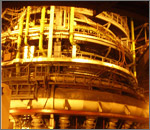Introduction: Blast furnace is the metallurgical furnace used for smelting iron and steel using coal or coke as fuel. In the 5th century BC the Chinese used blast furnace. Though many improvements are made in the furnace over the years, the basic operation of the furnace is the same.
 History:
History: The Chinese were the first to use blast furnace and later the technique spread to all the four corners of the world. Over the ages the production capacity of the furnace has gone up from 1 ton to 13300 ton per day. Coal which was used as fuel was replaced by coke only in the 15th Century. In some countries like Sweden, electric blast furnaces are used because of the unavailability of charcoal and coke. Blast furnace will be continued for another thousand years because iron can be smelted at an economical price.
Melting Process in Blast Furnace: In modern day, blast furnace operation is done within a well organized set-up. There is a store house for ores, an ore bridge to transport the ore from the yard to the furnace and “bell system” or valves for the controlled entry of the materials into the furnace. Some furnaces do not have bells but instead have 2 or 3 airlock type hoppers that discharge raw materials onto a rotating chute which can precisely place the ore inside the furnace
Blast furnace is a tall chimney-like structure with an upper part for filling the raw materials like ore, limestone and coke. Lower portion has the equipment is used for melting the iron and slag. The furnace which is line with refractory brick is mainly for the purpose of producing hot molten metals. When the ore is smelted, the pure ore deposits at the bottom and is removed by an iron runner. And the impurities which float on top are directed out through the slag runner.
Tuyers are used to hot blast into the furnace. The temperature of the blast can be 900°C to 1300°C depending upon the design of the furnace and other factors. Many chemical changes takes place in the furnace that produces pure metal and removes impurities. Preheated air which is blown into the furnace reacts with coke to produce carbon di oxide. Coke which reacts with the ore is also known as cooked coal. The main chemical reaction that takes place is
Fe2O3 + 3CO → 2Fe + 3CO2
Other than the molten iron and the slag, the other main produce in the hot dirty gases. To remove the dirt limestone is used as raw material. These gases that are formed exit the top of the blast furnace and proceed through gas cleaning equipment. The main reaction controlling the gas atmosphere in the furnace is called the Boudouard reaction:
C + O2 → CO2
CO2 + C → 2CO
 Blast Furnace Applications:
Blast Furnace Applications:
Pig iron produced from the blast furnace is converted into cast iron and then into steel. The slag is processed and used as roadfill or railroad ballast.
Advantages of Blast Furnace:
- Cost effective method for melting iron ores
- A blast furnace can continuously run for four to ten years with only short stops for maintenance.


